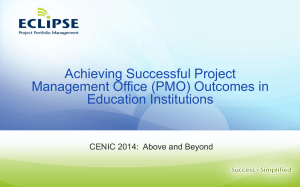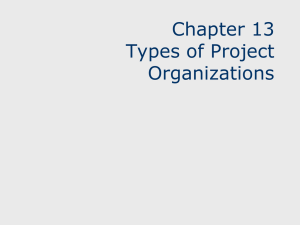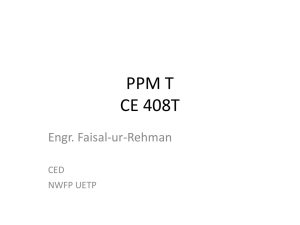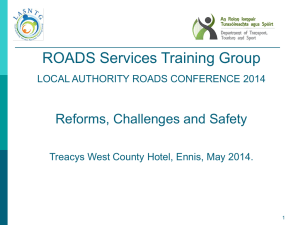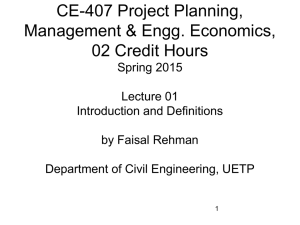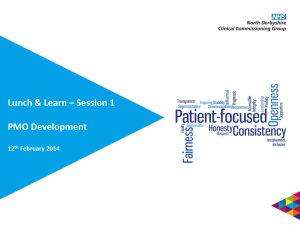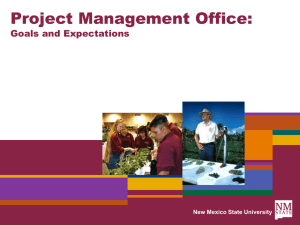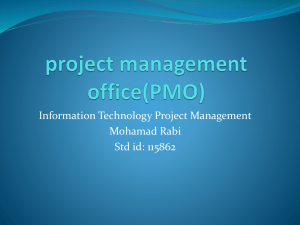EPMO Playbook-James Brown - Project Management Institute
advertisement
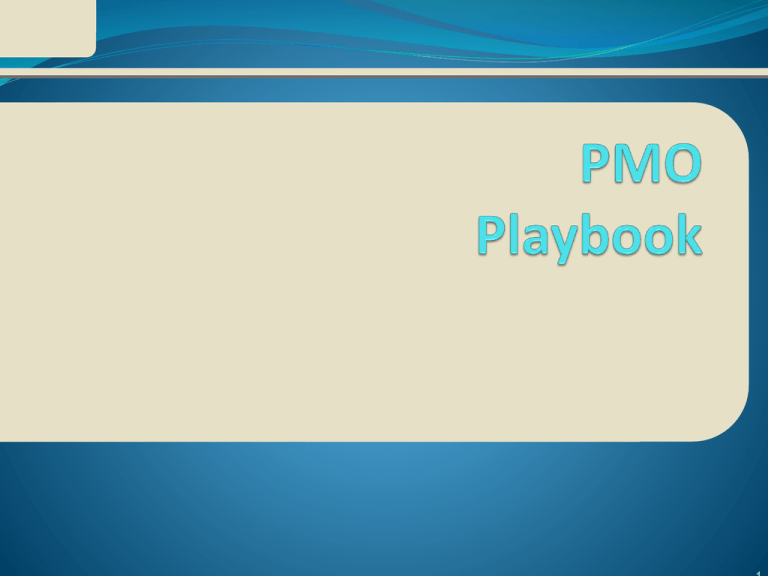
Intention of this Document This document is intended: to describe at a high-level the effort required to implement the Program Management Office (PMO). to cover the proposed lifecycle of the PMO from planning, to startup, to stabilization and finally to world-class. to provide a view of the roadmap planned an PMO. This document is not intended: to be detailed and complete in all areas. to be the playbook for program/project managers in individual businesses. for implementation outside of the PMO. PMO Purpose To provide the organizational focus on improving the management of projects and programs To optimize the capability and use of scarce resources To raise the strategic issues to the highest levels of the organization to facilitate effective decision-making Drive influence to extend from strategy formulation through benefits realization Integrate benefits realization into the entire life cycle starting with planning and report on it regularly Implement programmatic management tools that provide highlevel visibility and analysis that inform decision makers and evoke action Broaden competencies to include strategic planning and investment analysis PMO Critical Success Factors Executive support Appropriate Funding/Resources Acceptance of Program Managers Acceptance of Project Managers Acceptance by Business Managers Institutionalized Program/Project Management Culture Ultimate PMO Elements required for the Ultimate PMO A flexible, end-to-end project management process that balances rigor with overhead Easy to use tools to consistently plan, track, manage, and report all projects Easy access to process tools (intranet) along with supporting materials to increase adoption and compliance Formal training, coaching, and mentoring to develop competent project managers Ability to provide PM assistance – consulting, problem solving and audits Ultimate PMO cont’d. Elements required for the Ultimate PMO Institutionalized PM discipline Program-level visibility to identify and reduce resource contention and improve resource utilization Education for business and external stakeholders about shared responsibilities for ensuring program success Expanded PMO governance board to represent wider set of stakeholders Communications programs to keep all stakeholders informed and committed to program success Levels of Project Management Maturity Level 1 Initial Process Ad-hoc processes Management awareness Level 2 Structure Process and Standards Basic processes; not standard on all projects; used on large, high visible projects Management supports and encourages use Mix of intermediate and summary-level information Estimates, schedules based on expert knowledge and generic tools Mostly a project centric focus Levels of Project Management Maturity Level 3 Organizational Standards and Institutional Process All processes, standard for all projects, repeatable Management has institutionalized processes Summary and detailed information Baseline and information collection of actuals Estimates, schedules may be based on industry standards and organizational specifics More of an organizational focus Informal analysis of project performance Levels of Project Management Maturity Level 4 Managed Process Processes integrated with corporate processes Management mandates compliance Management takes an organizational entity view Solid analysis of project performance Estimates, schedules are normally based on organization specifics Management uses data to make decisions Levels of Project Management Maturity Level 5 Optimizing Process Processes to measure project effectiveness and efficiency Processes in place to improve Management focuses on continuous improvement PMO Implementation Visioning & Concept Definition Vision and mission Executive sponsor Guidance (steering) team Business case Political management strategy Approval to staff Readiness Assessments Organizational readiness assessment Maturity assessment Individual PM knowledge and skill assessment Implementation Planning Strategic alignment Scope Authority Services Organization Budget PMO Launch Standard Practices, Tools, Metrics Education & Training Consulting Services Visioning and Concept Definition Visioning & Concept Definition Vision and mission Executive sponsor Guidance (steering) team Business case Political management strategy Approval to staff Explore the business need 1. Determine current state of project performance 2. Document business need 3. Identify PMO sponsor(s) 4. Secure approval 5. Build the case 1. Current State of Project Performance Collect industry data on project performance Conduct a quick assessment of organizational project performance Identify the business need for improvement Conduct a gap and cause analysis between current and desired performance Identify the gaps in capabilities that are the causes of poor project performance 2. Business Need Define the business problem or need the PMO will satisfy Determine if the organization is ready for: Strategic level PMO or Tactical approach Prepare draft: Vision and mission Objectives and scope Measures of success in business terms 3. Sponsor(s) Identify one or more sponsors Interview the sponsors regarding the current state of projects in your Industry Organization Discuss the role of PMO in closing the gaps Identify executive success criteria 4. Approval to Proceed Staff a small PMO planning team to finalize the PMO detailing Vision and mission Objectives and scope Strategic alignment Establish measures to demonstrate PMO value Draft the business case 5. Build the Case Most likely PMO approach based on: Appropriate PMO model Scope considerations Organizational alignment, positioning and maturity Implementation approach Cost and benefit information Equate project performance data to a dollar figure Calculate ROI for expected change in performance Readiness Assessments Readiness Assessments Organizational readiness assessment PM practices maturity assessment Individual PM knowledge and skill assessment 1. Conduct organizational readiness assessment 2. Conduct individual competency assessment 3. Compile assessment findings 1. Organizational Readiness Assessment Purpose Determine organizational expectations Gauge the cultural readiness Gather information about best practices in the organization to use as a springboard for replication Uncover challenges, gaps and issues Increase the organization’s readiness to improve Method Interviews Small focus group discussions 2. Individual Competency Assessment To determine the skill level of existing project managers Uses a survey to assess level of competencies Delivers results to help determine: Training requirements Professional development activities, and Specific mentoring and coaching needs 3. Assessment Findings Report Compile assessment results in a formal document Use assessment findings to: Inform the business plan for the new PMO Assess risks and challenges Report Strengths Prioritized list of opportunities for improvements Readiness to accept and support the PMO Challenges identified in implementing the PMO Implementation Planning Summarize decisions about the PMO in a Charter to be used as a Business Plan: Implementation Planning Charter: - Strategic alignment - Scope - Authority - Services - Organization - Budget - Measures of Success 1. 2. 3. 4. 5. 6. 7. Select the appropriate PMO organization structure, governance Establish PMO guidelines Manage cultural change Prepare to demonstrate value Manage the path to maturity Develop a political management strategy and communication plan Present the Business Case and Charter to Guidance Team for approval 1. PMO Organization and Governance Structure Governance Team Executive Sponsor Director/Manager Program Management Office Admin Metrics/Reporting Best Practices Tools Assessments 2. PMO Guidelines 20% improve PM practices 40% support the execution framework 40% implement common reporting 1 2 3 3. Change Management Expect that only a limited amount of concurrent change may be absorbed Anticipate considerable amount of resistance Secure buy-in and support Lead, communicate and manage the change Use PMO Governance Team to communicate a compelling vision 4. Value Wrap mission around impact on the business Establish business measures Gain efficiencies Achieve cost savings Increase customer satisfaction Reduce time-to-market Increase revenue and profit Increase competitive advantage Value is not templates, tools, methodology, processes and training Source: http://www.chiefprojectofficer.com/article/146 5. Path to Maturity Stabilize performance by supporting basic project management practices before taking on sophisticated practices Transition to more sophisticated practices as momentum builds Limited Influence Phase 1 1 Phase Project Project Centric Centric Strategic Influence Phase 2 Department Focus Phase Phase 3 3 Strategic Strategic Asset Asset 6. Communication and Political Management Communication Plan Political Management Strategy • • • • Determine which stakeholders • Identify stakeholders Conduct an audience analysis Document information needs, messages, media and frequency Use guidance team to constantly communicate – – – – Vision and mission Objectives Business drivers Value – Can influence the PMO, and – Feel positively or negatively about it • Identify stakeholders’ goals • Assess the political environment • Define problems, solutions, and action plans to – Leverage positive influences – Neutralize negative ones 7. Approval of Guidance Team Organize, structure and convene the PMO Guidance Team Ensure that any issues, conflicts and inconsistencies have been resolved before the meeting Summarize the contents of the business case and charter Seek approval to proceed with formal launch of the PMO Launch the PMO PMO Launch Standard Practices & Tools Measurement & Accountability Professional Development Professional Services Portfolio Management Support 1. 2. 3. Conduct PMO Kickoff Build a great team Build a PMO to last 1. PMO Kickoff Capstone event officially launching the PMO All key stakeholders are in attendance Purpose Finalize the charter and gain consensus on an implementation approach Prior to the kickoff Areas of resistance have been resolved Charter and business case approved Buy-in of influential stakeholders secured 2. The PMO Team Establish a small core dedicated leadership team Augment with SMEs and sub-teams Select team members based on their passion 3. A EPMO to Last Executives Love: • Drive 50% more projects to completion – Without increasing resources • Complete 25% more projects – In drastically shorter times • PMO impact is clearly felt throughout organization • Management sees benefits of PMO Teams Trust: • Viewed as indispensable • Gains credibility one project at a time • Provides valuable services – – – – – – – Project kick-off workshops Coaching and mentoring Methods scaled to meet project needs Training and education Communities of practice Stage gate review preparation Business case reviews Source: Gerald I. Kendall and Steven C. Rollins, Advanced Project Portfolio Management and the PMO, J. Ross Publishing, 2003 Expect Challenges Project managers applaud their increased control But loathe the accountability Managers enjoy the visibility of project progress But scoff at the added level of communication needed to get things done Executives like the deliberate assignment of responsibilities But balk at the investment necessary to support a central resource Source: Donn DiNunno CCP, CDP, Program Management Office (PMO) Basics, Engineering, Management, and Integration, Inc. 20 Avoid Pitfalls Lack of focus and too many responsibilities Placed too low in the organization Relegation to clerical role Excessive time developing process and tools Perception of not adding value Viewed as: Worthless resource “Project police”
